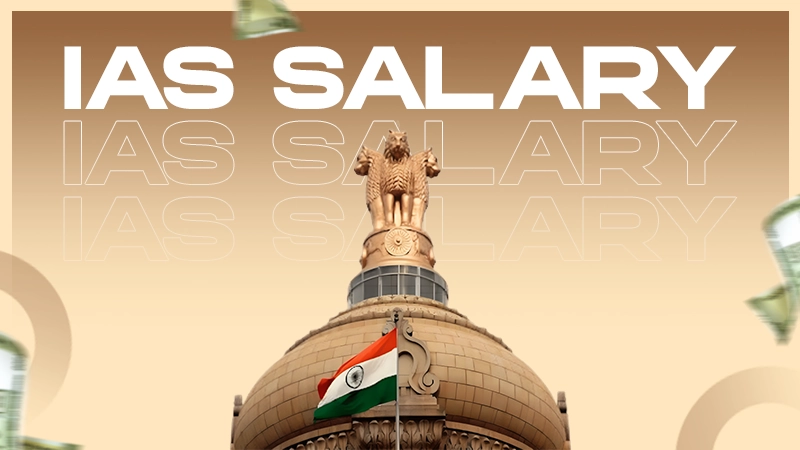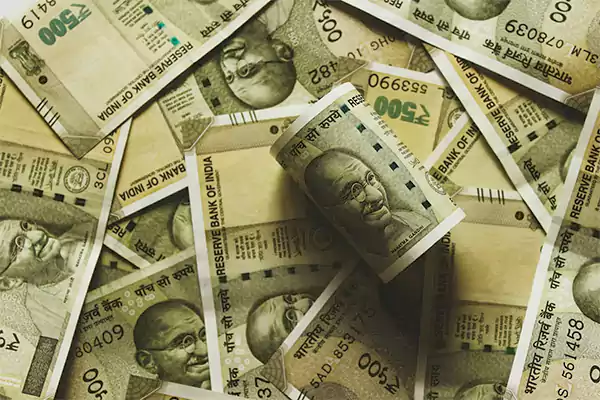
Getting selected in the IAS (Indian Administrative Service) is a big opportunity in India. There comes a huge earning potential with great power and responsibility. An IAS salary can reach up to lakhs in a month with seniority, making it a very sought-after government job option.
Millions of aspirants give this exam a try each year with straining preparations, but only a handful of lucky ones are selected. So, if you are curious about how much an IAS officer earns & what the growth potential is, continue to read this article till the end.
What is the IAS Salary Per Month?

The IAS Salary per month depends on the current post of an officer. For instance, if an IAS officer has just joined the service, then his monthly basic pay will be ₹56,100. The basic pay starts from this level because IAS is one of the highest civilian jobs in India.
During the training period, an IAS officer starts from this salary level (₹56,100) and reaches to lakhs after the promotions.
Furthermore, when the same officer gets promoted to a higher post after having spent a certain number of years in the service, the pay also increases.
For example, suppose an officer has completed 5 years in the service. In that case, the IAS officer salary per month will be somewhere around ₹67,700.
Hence, how much an IAS officer’s salary is in a month varies from officer to officer.
Also Read: Study Techniques for Competitive Exams: Enhancing Preparation with Effective Methods
IAS Officer Salary 2025 Structure (7th Pay Commission)
From time to time, pay commissions are formed by the government of India to make well-informed recommendations regarding amendments in the salary structures of civil and defence officers, including IAS. These committees are mainly formed to accommodate the negative effects of the rising inflation on current pay levels.
Thus, the following table deals with the question, ‘What is the salary of IAS after 7th pay commission?’
| 2025 Salary Structure (Including Starting Salary of IAS) |
| S. No. | Basic Pay (₹) | Number OfService Years | Post |
| District Administration | State Secretariat | Central Secretariat |
| 1. | ₹56,100 | 1-4 | Sub-Divisional Magistrate | Undersecretary | Assistant Secretary |
| 2. | ₹67,700 | 5-8 | Additional District Magistrate | Deputy Secretary | Undersecretary |
| 3. | ₹78,800 | 9-12 | District Magistrate | Joint Secretary | Deputy Secretary |
| 4. | ₹1,18,500 | 13-16 | District Magistrate | Special Secretary-cum-Director | Director |
| 5. | ₹1,44,200 | 16-24 | Divisional Commissioner | Secretary-cum- Commissioner | Joint Secretary |
| 6. | ₹1,82,200 | 25-30 | Divisional Commissioner | Principal Secretary | Additional Secretary |
| 7. | ₹2,05,400 | 30-33 | No Equivalent Rank | Additional Chief Secretary | No Equivalent Rank |
| 8. | ₹2,25,000 | 34-36 | No Equivalent Rank | Chief Secretary | Secretary |
| 9. | ₹2,50,000 | 37+ | No Equivalent Rank | No Equivalent Rank | Cabinet Secretary of India |
The simple and year-wise promotion is very important in the professional life of an IAS officer due to the fact that it provides enough motivation to complete the tenure without resigning before retirement. Additionally, the post you get promoted to also depends on the magnitude of experience in the service—the higher the experience, the higher the post.
The Highest IAS Officer Salary Level
According to the 7th Pay Commission, the highest IAS Salary in India is ₹2,50,000 per month. This pay is only given to the officer who has completed 37+ years in the service and so attained either of the posts, such as No Equivalent Rank, or Cabinet Secretary of India!
Both posts are very high in status and thus put a lot of responsibilities on the shoulders of the concerned officers. As the pay increases with the post, work also becomes strenuous and demanding. Thus, not just the highest salary but also consider the nature of the work associated.
Also Read: 25 Best Marine Biology Colleges Around the World
Changes in IAS Salary After 10 Years
Amendments to an IAS officer’s salary and post are quite simple. The algorithms solely depend on the years spent in the service. It has been amply discussed and explained in both the tables above.
Hence, as far as the IAS salary after 10 years is concerned, it almost reaches the pay level 14 with the basic pay around ₹1,44,200 each month. For other posts, salaries are as follows.
| Level 12 | District Magistrate | ₹78,000 |
| Level 13 | Joint Secretary | ₹1,18,500 |
| Level 14 | Additional Secretary | ₹1,44,200 |
| Level 15 | Principal Secretary | ₹1,82,200 |
Additionally, the actual pay might fluctuate due to other factors such as the location of posting, extra payments made in addition to the basic pay, the magnitude of dearness allowance, etc.
Also Read: College vs. University: Understanding the Difference and Purpose
Learning About IAS Grade Pay
IAS officers are paid according to the applicability of specific grade pay. However, it has now been replaced with the new mechanics of pay metrics. In the new system, an officer is paid for the work done in a month according to the number of pay matrix levels.
The following table summarises all grade pays with pay bands. Not every person in service gets the same pay; thus, the term ‘Pay Band’ is used to refer to the general range in which a particular post holder’s salary would lie.
| IAS Grade Pay |
| Pay Band (₹) | Grade Pay (₹) | Pay Matrix Level (₹) | Designations |
| ₹15,600-₹39,100 | ₹5,400 | 10 |
- Sub-Divisional Magistrate (SDM)
- Undersecretary in the State Secretariat
- Assistant Secretary in the Central Secretariat
|
| ₹6,600 | 11 |
- Additional District Magistrate (ADM)
- Deputy Secretary in the State Secretariat
- Under-Secretary in the Central Secretariat
|
| ₹7,600 | 12 |
- District Magistrate (DM)
- Joint Secretary in the State Secretariat
- Deputy Secretary in Central Secretariat
|
| ₹37,400-₹67,000 | ₹8,700 | 13 |
- DM (Director in the Government of India)
- Additional Commissioner in the IRS
- Joint Commissioner in IRS
|
| ₹10,000 | 14 |
- Inspector General (IG) of Police
- Commissioner (IAS/IRS)
- Joint Secretary in the GOI
|
| ₹67,000-₹79,000 | – | 15 |
- Additional Director General (ADG) of Police
- Additional Secretary in the GOI
- Principal Secretary in the GOI
- Principal Secretary in the State
- Principal Commissioner in IRS
|
| ₹80,000 | – | 17 |
- Chief Secretary of the State
- DG of Police
- Secretary in the GOI
- Principal Chief Commissioner in IRS
|
| ₹90,000 | – | 18 |
- Cabinet Secretary of India
|
Also Read: Med School Admissions: Guide to Increasing Your Chances of Acceptance
How Does an IAS Officer’s Career Growth Look Like?
The career growth of an IAS officer happens in a structured and organised manner over time, according to their ranking, posts, and other aspects of the service change. To provide a general idea of the same, consider the table below.
| IAS Officer Career Growth |
| Stage/Designation | Key Responsibilities |
| Probationary Officer (Entry Level) |
- Training & Skill Development
|
| Sub-Divisional Magistrate (SDM) |
- Subdivision administration
- Maintenance of law and order
|
- District Magistrate (DM)
- Deputy Commissioner
- Collector
|
- Administrative work
- Law and order maintenance
- Coordination with multiple departments
- Implementation of new schemes and policies
|
| Divisional Commissioner |
- Supervision of and coordination with multiple divisions
- Resolution of various issues under the jurisprudence
- Monitoring large-scale developmental government-sponsored activities
|
- Secretary
- Additional Secretary
- Joint Secretary
|
- Formulation and implementation of the state-level policies
- Administrative work under various government programs
- Advisory responsibility for state ministers
|
- Director
- Additional Director
|
- Overseeing specific GOVT. Departments
- Ensuring policy execution
- Monitoring progress and growth
|
- Principal Secretary
- Additional Chief Secretary
- Chief Secretary
|
- Offering assistance to top-level senior bureaucratic officials in the state
- Providing state ministers with advice and administrative aid
- Facilitating interdepartmental coordination for the successful completion of various events and activities
- Playing a crucial role in the policy formulation concerning a particular state
|
| Central Government Positions |
- Meant to work for centre ministers, departments, or autonomous bodies
- Contributing to policies concerning the whole of the nation
- Providing aid in the implementation of the central government schemes
|
- Additional Secretary
- Joint Secretary
- Secretary (CM)
|
- Managing national-level policymaking efforts
- Supervising the execution of central programs
- Ensuring coordination among ministers
|
| Cabinet Secretary (Apex Position) |
- Leading the civil service and administrative system
- Ensuring coordination among major policies and reforms
- Facilitating collaboration among ministers
- Providing key advisory to the GOI
|
The responsibility points mentioned in the right-hand column above are just a representation of the original work. As a result, it doesn’t encompass the entire arena. Instead, it is just major aspects of the duty associated with the mentioned titles (in the left-hand column).
Also Read: Is A 3.5 GPA Good to Get Into a Reputable Institution? Here is the Explained Answer
Additional Perks and Allowances Besides the IAS Salary

The salary of an IAS officer might take many students by surprise, as even the officer who has just joined the service earns more than ₹50,000, which is quite a lot for a trainee. But the remuneration doesn’t only include that, as there are other perks as well to complement the position.
Some major ones are outlined below.
- Dearness Allowance (DA): This is a payment made in addition to the basic pay to offset the effects of the prevailing inflation level.
- House Rent Allowance (HRA): An aid provided to an IAS officer for living in a rented accommodation near the area of posting.
- Medical Allowance: The government provides free medical check-ups and treatment for the officer and their family members.
- Transport Allowance: An IAS officer has to travel to various locations and places for work purposes. Thus, expenses during the travel are managed by the government either directly or through reimbursements.
- House Help Benefits: Aids like cooks, security guards, maids, and gardeners are also provided.
- Mobile Bills: Perks also include the reimbursement of mobile bills.
- Place of Residence: Officials are also helped with the allotment of residential properties for accommodation during their active years of service.
- High Security: IAS officers are a very crucial part of India’s administrative system. Thus, all of them are provided with high security at home as well as in the workplace.
- Study Leaves: If someone wants to pursue a course in any foreign university, the government also allows for long-term leave, i.e., for 2–4 years, which is a very impressive perk in itself. The cost of the education is borne by the concerned authorities.
- Job Security: There is 100% job security, so officers don’t need to worry about a sudden career break and the concomitant problems arising out of the same situation.
- Pension & Retirement Benefits: There are benefits to enjoy even after retirement. The biggest one is the pension, which helps ensure an easy and hassle-free life after the end of the service. Additionally, a retired person can also be appointed to tribunals and other government bodies for an extra stream of income.
Hence, the hard work pays off once you get selected for the service. It might be super demanding and challenging to study and complete the voluminous syllabus, but life takes an ultra-comfortable turn after passing the exam and joining the service. The true testament to this fact is the list of allowances and perks on top of the basic pay as mentioned above.
Also Read: Advantages and Disadvantages of Online Education: Extensively Explained and Answered
Comparison Between IPS vs IAS Salary
There is no difference between the basic pay of a starting IPS and an IAS, as it is ₹56,100 per month. However, allowance and perks differ to a certain extent. The nature of work is different from each other. Furthermore, as per the number of years spent in the service, the rank, and the salary change.
Thus, the growth is steady and time-bound for both types of titles. Moreover, the highest both officials can go up to is ₹2,50,000 per month.
Why Should You Know About IAS Salary?
You must know how much an IAS salary is in a month for several reasons, such as maintaining motivation, justifying the turmoil, having context for responsibility, dispelling myths, making informed decisions, and planning life after selection accordingly.
- Motivation: It might motivate many aspirants to do better, as the higher the remuneration is, the more comfortable life becomes!
- Justification: Having an in-depth understanding of the IAS officer’s salary is also crucial because it enables an aspirant to subjectively analyse whether the pay is justifiable or not!
- Context for Responsibility: A high salary often corresponds to high responsibility and work pressure. Thus, this can be gauged through the magnitude of basic pay.
- Dispelling Myths: There is a lot of wrong information around about the remuneration of an IAS officer. Thus, having the exact knowledge will help beat misconceptions and the following myths.
- Informed Decision: If someone finds the basic IAS salary doesn’t justify the turmoil before selection, they can make a change of plans, taking an informed decision.
- Planning Accordingly: Selected candidates must know how much they are going to make each month, so that they can plan and distribute their pay accordingly.
Furthermore, in addition to basic and total salary, trainees are also advised to have an in-depth understanding of all the available additional benefits, so that they can make the most out of the service.
Also Read: Top BBA Colleges In India for Admission in 2025
Conclusion
So, the basic IAS salary is ₹56,100, and over time, it can reach up to ₹2,50,000 per month. This can be the most alluring aspect of this service. However, getting selected is a tough game, as it includes the study of almost all the general subjects.
The key to success, however, of course, lies in the strategic preparation where you make a perfect balance between the syllabus coverage and past years’ question trends. With smart work and dedication, every aspirant can reach their cherished goal, even though it has to do with cracking India’s most demanding and strenuous civil service exam!
FAQs
Ans: According to the implementation of the recommendations by the 7th Pay Commission, the basic IAS salary is ₹56,100, and over time, it can reach up to ₹2,50,000 per month.
Ans: The IAS officer who only takes 1 rupee symbolic salary is Amit Kataria, a pass-out of the 2004 batch.
Ans: No, it is decent and reaches lakhs with seniority. At the time of joining the service, the officer earns up to ₹56,100, which is not very low. However, it also depends on the subjective perception.
Ans: No, it is not possible, as the highest their salary can reach is up to ₹2.5 lakh per month.